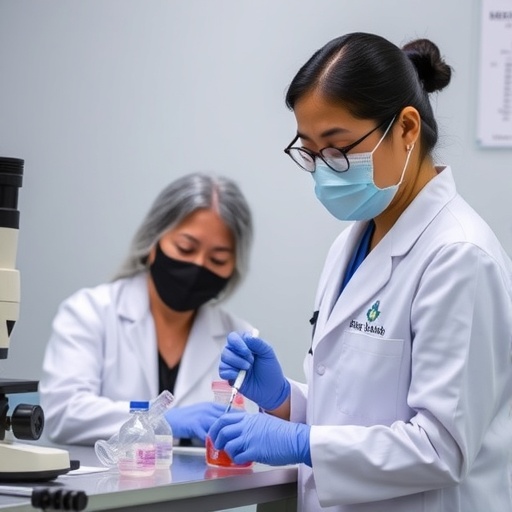In recent years, non-communicable diseases (NCDs) have surged to the forefront of global health challenges, especially in low- and middle-income countries. A pivotal study spearheaded by researchers, including Albitres-Flores and Huayanay-Espinoza, demonstrates the groundbreaking implementation of multiparameter point-of-care testing devices designed specifically for diagnosing NCDs at the primary healthcare level in Peru. This innovative approach not only aims to improve health outcomes but also addresses critical gaps in healthcare accessibility.
The significance of this research lies in the alarming rise of NCDs, such as cardiovascular diseases, diabetes, and cancer. These conditions often require timely and accurate diagnosis for effective management and treatment. Traditional testing methods, which typically involve laboratory facilities, are often inaccessible in rural and underserved areas. This means that many patients may go undiagnosed or receive delayed treatments, exacerbating their health issues.
Point-of-care testing (POCT) devices allow for rapid, on-site diagnostics, eliminating the need for patients to travel long distances to receive laboratory services. This is particularly crucial in a country like Peru, where geographical barriers can impede access to necessary healthcare. The research highlights how the integration of these multiparameter devices can bridge this gap, delivering essential health services directly within communities.
The study meticulously outlines the functionality of these POCT devices, which can assess multiple health parameters simultaneously. Equipped to detect a range of conditions from blood glucose levels to cholesterol, these devices provide healthcare providers with rapid results that inform clinical decision-making. By facilitating quicker diagnoses, these devices not only enhance patient outcomes but also empower healthcare providers to tailor treatment plans more effectively.
Training healthcare professionals on the use of these devices is another critical component of the study. The successful implementation of POCT devices hinges on the proficiency of medical personnel in utilizing these tools. The research emphasizes the importance of comprehensive training programs to equip primary care providers with the necessary skills and knowledge. This investment in human capital is essential for ensuring sustained improvements in healthcare delivery.
In their findings, the authors also note the financial implications of POCT implementation. While there are upfront costs associated with acquiring these devices, the potential for long-term cost savings is significant. By offering immediate diagnostics, healthcare systems can reduce the burden of late-stage interventions, which are often far more expensive. The study presents data illustrating how early detection and management of NCDs can lead to more efficient resource allocation within the healthcare sector.
Engaging community stakeholders is another focal point of this research. Successful healthcare initiatives require the buy-in and support of local populations. The authors detail strategies for involving community members in the implementation process, ensuring that solutions are tailored to their specific needs. By fostering a sense of ownership among community members, healthcare providers can enhance the sustainability of these interventions.
Furthermore, the research delves into the broader implications of improving primary healthcare through POCT devices. Strengthening health systems in Peru not only benefits individual patients but also contributes to national public health goals. Enhanced detection and management of NCDs can lead to improved workforce productivity and economic stability, creating a ripple effect that benefits society as a whole.
The implementation of these strategies is not without challenges. The study acknowledges potential barriers such as funding constraints, infrastructural limitations, and logistical hurdles in deploying technology to remote areas. Nevertheless, the researchers are optimistic, suggesting that targeted interventions and collaborative efforts among government, non-profit organizations, and private sectors can overcome these obstacles.
In addition to the immediate health benefits, the POCT initiative has the potential to pave the way for future innovations in healthcare technology in Peru. By establishing a framework for effective testing and management of diseases within primary healthcare settings, the possibility for scaling these efforts to include other health crises, such as infectious diseases or maternal health, becomes increasingly feasible.
As the Peruvian healthcare system evolves, the findings of this study may serve as a model for other countries facing similar challenges with NCDs. The lessons learned from the integration of multiparameter POCT devices could inspire global initiatives aimed at improving health outcomes in resource-limited settings.
The study’s conclusions are a clarion call for further research and investment in healthcare technologies that empower frontline providers. Real-time data collection and analytics facilitated by these devices can lead to improved health monitoring and policy-making, ultimately benefiting entire populations.
In establishing a robust public health response to NCDs, the study recognizes that the achievement of health equity is paramount. By directly addressing the barriers to access and quality care, the implementation of multiparameter testing devices has the potential to transform the landscape of primary healthcare in Peru and beyond.
As we look to the future, ongoing collaboration between researchers, healthcare providers, and community stakeholders will be essential to extend the reach and impact of this vital initiative. The commitment to leveraging technology in service of public health is not only commendable but necessary in our ongoing battle against non-communicable diseases.
With the promising results presented in this research, there is hope that Peru can take significant strides toward addressing the challenges of NCDs. The increased accessibility to timely diagnostics paves the way for healthier communities and a more resilient healthcare system, exemplifying the power of innovation in public health.
Subject of Research: Multiparameter point-of-care testing devices for non-communicable diseases in primary healthcare.
Article Title: Implementation of multiparameter point-of-care testing devices for non-communicable diseases at primary healthcare level in Peru.
Article References:
Albitres-Flores, L., Huayanay-Espinoza, C.A., Safary, E. et al. Implementation of multiparameter point-of-care testing devices for non-communicable diseases at primary healthcare level in Peru. BMC Health Serv Res 25, 1426 (2025). https://doi.org/10.1186/s12913-025-13554-3
Image Credits: AI Generated
DOI: 10.1186/s12913-025-13554-3
Keywords: Non-communicable diseases, primary healthcare, point-of-care testing, Peru, health equity, healthcare technology, community engagement.




